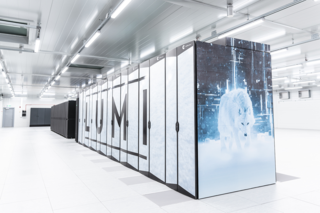Research Interests (for non-specialists)
My research is in particle physics which studies how the smallest,
fundamental particles interact and make up everything we see around
us. These fundamental particles are tiny - they are smaller again than
protons, and a proton is around a million millionth of a millimetre
across.
As far as we know, there are only four types of interactions (forces) which, unbelievably, give us all of the phenomena of Mother Nature - from DNA to photosynthesis to the reactions in the core of stars to the gravitation pull that keeps the moon going around the earth to the inner workings of electronics.
These four forces are: gravity; electromagnetism; the weak force; and the strong force. (Physicists aren't very inventive when it comes to naming things!) My field of research is the strong force. This controls the motion of tiny particles called quarks which bind together in three to make up protons and neutrons, and therefore 99% of the matter that's observed in the universe.
The strong force is studied by experimentalists in laboratories like CERN. By using these observations, we believe we have a very good theory which accurately describes the strong force, much like Newton's Law of Gravity (quite) accurately describes the motion of the planets, cricket balls etc etc. While our theory of the strong force appears to be The Theory of the strong interaction, it turns out that we can't always make predictions from it to be absolutely definitive about this statement. This is for two reasons. The first is that it is quantum-mechanical (so, very weirdly, quarks can be in two places at once!). The second is that it is incredibly strong, and it does NOT decrease with distance.
This second feature is particularly important. When the Apollo 11 capsule was sent to the moon, NASA scientists could calculate its motion by including the gravitational effects of the earth, the moon and the sun. They didn't need to include the pull of gravity from the distant Andromeda galaxy - that was simply so far away that the effect was totally negligible.
However, the strong force equivalent would have to include the interaction of all the matter in the universe. Why? This is because the strong force does NOT decrease with distance, so all quarks, no matter how far away, exert a significant force, and so they all should be included in the calculation!
This seems like an impossible theory to deal with. However, by using computer simulations, we have made a great deal of progress into understanding and making predictions of the strong force of nature. It requires a large amount of computer time on some of the world's most powerful supercomputers. My research involves putting the theory of the strong interaction onto computers so that they can simulate quarks and we can answer the question: how do they interact to make protons etc and virtually all of the matter in the known universe?
Organisations I'm Involved With
News Items
EuroHPC Supercomputing Grant
October 2023
 The FASTSUM collaboration was awarded 111 million core hours of computer time on the world’s third fastest supercomputer.
The FASTSUM collaboration was awarded 111 million core hours of computer time on the world’s third fastest supercomputer.
1;95;0c
Sabbatical in Australia
July 2023
 I am very lucky to be able to return home to Australia for a sabbatical semester. I’ll be based at the Universities of Queensland and Adelaide.
I am very lucky to be able to return home to Australia for a sabbatical semester. I’ll be based at the Universities of Queensland and Adelaide.
Oriel Science’s Imaging Exhibition
June 2023
 It was so exciting to welcome over 200 people to the opening our new Imaging exhibition on the 13th June. Dr Alex Hildred from the Mary Rose Trust was our guest and formally launched the exhibition.
It was so exciting to welcome over 200 people to the opening our new Imaging exhibition on the 13th June. Dr Alex Hildred from the Mary Rose Trust was our guest and formally launched the exhibition.